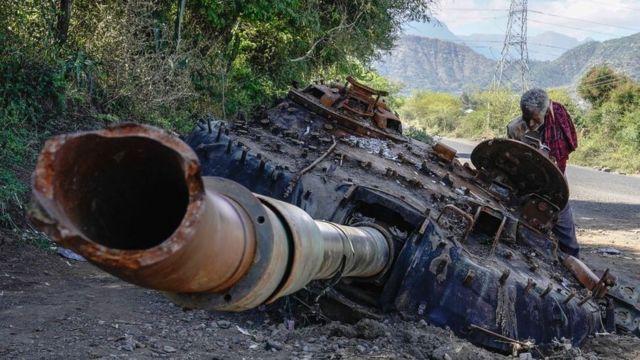The past months have witnessed the killing of dozens in air strikes targeting the Tigray region in northern Ethiopia.
Some of these attacks were carried out using offensive aircraft, and concerns about civilian casualties increased.
The government, which has been fighting the rebels for more than a year, says it has the right to use any weapons it sees appropriate, but at the same time it denies targeting civilians..
January 8: An attack targeting a camp for the displaced
An air attack targeting a camp for the displaced in the Didett area of Tigray on January 8, killing more than 50 people and wounding more than 100 others..
The photos published in the wake of the attack, which were submitted by relief workers to the Politico News Agency, prompted the belief that one of the weapons used in this attack may have been a missile fired from a Turkish -made plane "Bayrakdar TB2"..
تخطى مواضيع قد تهمك وواصل القراءةمواضيع قد تهمكTopics that may interest you end
It appears that the fragments, including cutting the wings, are identical to the appropriate type of these drones, according to researchers from the Netherlands -based peace group and Amnesty International.
Wim Zojenburg, an investigator working for the "Pax" Foundation, revealed the presence of Turkish drones in Ethiopia last December..
And highlighting satellite photos showing Turkish march planes standing at a government air base south of the Tigray region.
It could be determined by comparing the dimensions, including its wings and length.
It is not yet known whether these drones were used in this attack or not, nor did the Ethiopian government not confirm their use..
Turkey signed a defensive cooperation agreement with Ethiopia last year, despite the lack of announcement of the details of the agreement.
Reuters news agency said in December that the United States expressed concern to the Turkish government about the sales of the aircraft running Ethiopia.
January 6: An attack targeting the Oromo rebels
The attack was carried out in early January and targeted the rebels in the Oromia region, who joined a common issue with the rebels in Tigray.
Only a few details were known, and it is not clear if the attack resulted in casualties.
Nevertheless, the air strike that was carried out in the Gidami area left some evidence, rocket shrapnel, indicating, according to an investigation, to the use of Iranian ammunition..

Last December, satellite images revealed the presence of an Iranian plane at Harar Mida Airport, and its dimensions and other characteristics were determined..
An expert investigator in flight tracking has identified about 15 shipping flights from Iran to the Herra Mida and Bowa airports in August 2021, but the shipments it carried has become unknown..
Despite this, the American authorities have publicly condemned Iran last October, due to its exports of the drones, and described Ethiopia as one of the countries that get the technology of Iranian drones..
December 16: An attack targeting the Soua Market
In mid -December 2021, a series of air attacks resulted.
The Tigray People's Liberation Front carried out the responsibility for attacking government aircraft and drones.
A video clip was also shown on the Tigray TV channel, showing the remnants of a missile said to have been used in this attack.
The shots can be recognized on the missile exhaust tube, which tends to resist the collision.
An open investigation concluded, using information available to the public in an effort to determine exactly what happened, that based on these pictures, shrapnel looked identical to the Chinese -made "Blue Arrow" missile that can be installed on a plane.
Satellite photos revealed that Chinese -made "Wing Long" was standing at the Harar Mida Military Air Force Base in Ethiopia on December 15, on the day before the attack in Soda.
Investigators believe that China was the original source of "Wig Long" aircraft in Ethiopia, which was initially intended for use in monitoring operations.
The data received from applications tracking cargo trips shows the presence of charging operations from the Chinese city of Chengdu, which is located in the headquarters of the company "Chengdo Airecraft" for the manufacture of state -owned aircraft, to Ethiopia in September and October last year.
However, there is another country that has "Wig Long" and Blue Arrow missiles and has also sent supplies to Ethiopia, it is the Emirates.
The weapons database, at the Stockholm International Peace Research Institute, indicates that the UAE possesses all the running "Wing Long" aircraft and "Blu Aro" missiles..
Flight data research shows the registration of 119 shipping flights during the past five months from the UAE military airports to the Harar Mida Air Force Base (southeast of the capital Addis Ababa) and Bowa, the main international airport in the capital, and also we cannot confirm what these trips were carrying.
What do Ethiopia say?
Legis Tolo, a spokesman for the Ethiopian government, refused to talk about the details of the aforementioned attacks.
He told the BBC: "I will not say where, but the government used it (the drone) at different times and places." He insisted that it did not target civilians.
We do not know the certainty of the timing of the supply of these drones.
The BBC has contacted the concerned governments on reports that the offensive aircraft were used from other countries in Ethiopia, but they did not want.
We also contacted the Turkish Defense Company, which manufactures the running "Bayrakdar" plane, but we did not get a response.
There is no arms ban on Ethiopia at the present time, and the export of offensive aircraft in international regulations and treaties has not yet been decided..
It appears that the use of drones is increasing in conflict areas around the world.
Wim Zojenburg, of the "Pax" Foundation, believes that the example of Ethiopia "raises serious questions, taking into account the many allegations about violations of international law..
